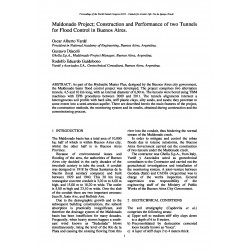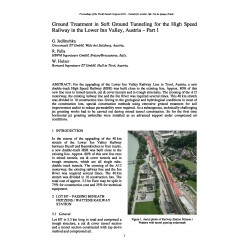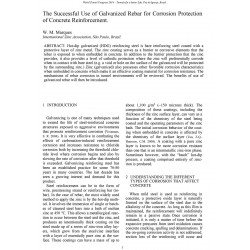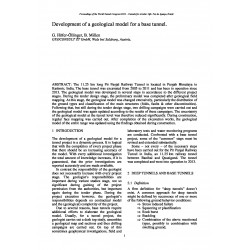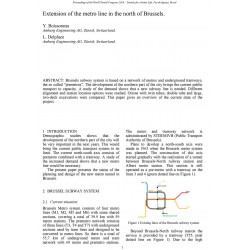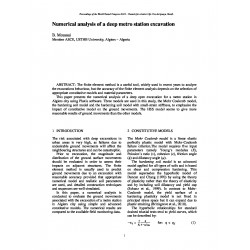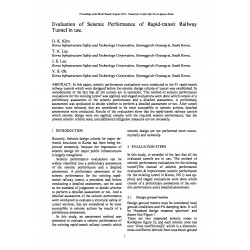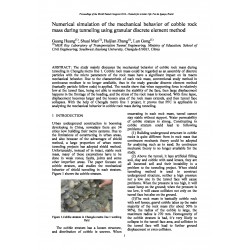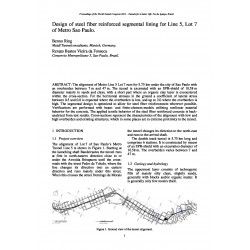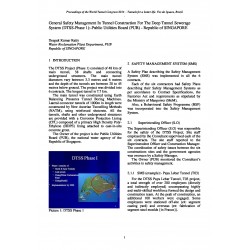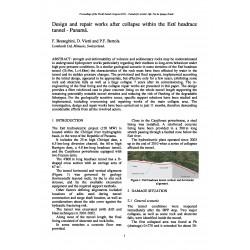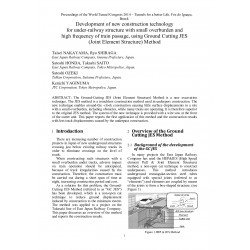No document
Search & filter
Search for a publication
Search & filter
Papers from WTC and ITA conferences have been made available as PDF documents.
ProceedingsThere are 1984 documents.
List of endorsed conferences
-
WTC
World Tunnelling Congress
-
Maldonado Project: Construction and Performance of two Tunnels for Flood Control in Buenos Aires
Abstract: As part of the Hydraulic Master Plan, designed by the Buenos Aires city government,the Maldonado basin flood control project was developed. The project comprises two alleviation tunnels, 4,5 and 10 km long, with an internal diameter of 6,90 m. The tunnels were bored using TBM machines with EPB procedures between 2009 and 2011. The tunnels alignments intersect a heterogeneous soil profile with...
0,00 € -
Safety of Subway Structures in Proximity of New Construction of a High-Rise Building
Abstract: Underground spaces in the Tokyo Metropolitan area have dense clusters of infrastructure facilities such as subways, and their effects must be taken into account when a building is to be constructed. In addition, the ground in the Tokyo area consists of deposits of soft soils, which exert further remarkable effects. When a high-rise building is constructed in the proximity of an existing subway...
0,00 € -
Ground Treatment in Soft Ground Tunneling for the High Speed Railway in the Lower Inn Valley, Austria – Part 1
Abstract: For the upgrading of the Lower Inn Valley Railway Line in Tyrol, Austria, a new double-track High Speed Railway (HSR) was built close to the existing line. Approx. 80% of this new line runs in mined tunnels, cut & cover tunnels and in trough structures. The crossing of the A12 motorway, the existing railway line and the Inn River was required several times. This 40 km stretch was divided in 10...
0,00 € -
The Successful Use of Galvanized Rebar for Corrosion Protection of Concrete Reinforcement
Abstract: Hot-dip galvanized (HDG) reinforcing steel is bare reinforcing steel coated with a protective layer of zinc metal. The zinc coating serves as a barrier to corrosive elements that the rebar is exposed to when embedded in concrete. In addition to the barrier protection that the zinc provides, it also provides a level of cathodic protection where the zinc will preferentially corrode when in...
0,00 € -
Development of a geological model for a base tunnel
Abstract: The 11.25 km long Pir Panjal Railway Tunnel is located in Punjab Himalaya in Kashmir, India. The base tunnel was excavated from 2005 to 2011 and has been in operation since 2013. The geological model was developed in several steps in accordance to the different project stages. During the tender design stage, the preliminary model was completed after geological field mapping. At this stage, the...
0,00 € -
Extension of the metro line in the north of Brussels
Abstract: Brussels subway system is based on a network of metros and underground tramways, the so called “premetros”. The development of the northern part of the city brings the current public transport to capacity. A study of the demand shows that a new subway line is needed. Different alignment and station location options were studied. Otions with twin tubes; double tube and large, two-deck...
0,00 € -
Numerical analysis of a deep metro station excavation
Abstract: The finite element method is a useful tool, widely used in recent years to analyze the excavations behaviour, but the accuracy of the finite element analysis depends on the selection of appropriate constitutive models and material parameters. This paper presents the numerical analysis of a deep open excavation for a metro station in Algiers city using Plaxis software. Three models are used in...
0,00 € -
Evaluation of Seismic Performance of Rapid-transit Railway Tunnel in use
Abstract: In this paper, seismic performance evaluations were conducted to the 91 rapid-transit railway tunnels which were designed before the seismic design criteria of tunnel was established. In consideration of the fact that all the tunnels are in operation, 'The method of seismic performance evaluations for the existing tunnel' was applied, and staged evaluations were done which consist of a...
0,00 € -
Numerical simulation of the mechanical behavior of cobble rock mass during tunneling using granular discrete element...
Abstract: The study mainly discusses the mechanical behavior of cobble rock mass during tunneling in Chengdu metro line 1. Cobble rock mass could be regarded as an assembly of discrete particles with the micro parameters of the rock mass have a significant impact on its macro mechanical behavior. Due to the characteristic of such rock mass, conventional study method in continuous medium is no longer...
0,00 € -
Building damage assessment due to tunnelling - Metro Line 3 of Santiago, Chile
Abstract: The construction of urban tunnels is a great and complex challenge in cities with old buildings. The new Santiago Metro Line 3 will cross the city centre and its route will be close to several historic buildings. Most of those buildings are characterized by some level of damage, usually caused by previous seismic activity. This article summarizes the building damage assessment due to the...
0,00 € -
Water supply and water drainage system of the Gotthard Base Tunnel including a mini power plant: a complex,...
Abstract: To ensure operational and safety requirements a complex multipurpose water supply and drainage system scheme has been set in the 57 km long Gotthard Base Tunnel (GBT). The water supply system makes it possible to refill the fire-extinguishing-and-rescue trains at two locations in each single track tube, to provide cooling water for the underground installed cooling systems, as well as to...
0,00 € -
Design of steel fiber reinforced segmental lining for Line 5, Lot 7 of Metro Sao Paulo
Abstract: The alignment of Metro Line 5 Lot 7 runs for 5.75 km under the city of Sao Paulo with an overburden between 7 m and 47 m. The tunnel is excavated with an EPB-shield of 10.58 m diameter mainly in sands and clays, with a short part where an organic clay layer is encountered within the cross-section. For the horizontal stresses in the ground a coefficient of lateral stress between 0.5 and 0.8 is...
0,00 € -
General Safety Management In Tunnel Construction For The Deep Tunnel Sewerage System (DTSS-Phase 1) - Public...
Abstract: The DTSS Project (Phase 1) consisted of 48 km of main tunnel, 38 shafts and connecting underground structures. The main tunnel diameters vary between 3.3 metres and 6 metres and the depth of the tunnels are between 20 to 45 metres below ground. The project was divided into 6 contracts. The longest tunnel is 7.7 km. The main tunnel was constructed using Earth Balancing Pressures Tunnel Boring...
0,00 € -
Critical review of spray-applied membranes in the field of tunnelling in comparison to sheet membranes: Advantages,...
Abstract: Terms like ‘the 21st century approach’, ‘a new level of protection’, ‘innovative, costeffective method for tunnel waterproofing’, ‘a future design for dry’, ‘water resistance for hydrostatic pressures up to 100 bars’ [Ouellet 2013] and ‘significant project savings’ have introduced the technology of spray-applied membranes to the tunnelling industry in the last couple of years, providing high...
0,00 € -
Design and repair works after collapse within the Estí headrace tunnel – Panamá
Abstract: strength and deformability of volcanic and sedimentary rocks may be underestimated in underground hydropower works particularly regarding their medium to long-term behaviour under high pore pressure conditions. In a similar geological scenario in some stretches of the Estí headrace tunnel (D=9m, L=4.8km) the characteristics of the rock mass have been affected by water in the tunnel and its...
0,00 € -
Development of new construction technology for under-railway structure with small overburden and high frequency of...
Abstract: The Ground-Cutting JES (Joint Element Structure) Method is a new excavation technique. The JES method is a trenchless construction method used in underpass construction. The new technique enables around-the -clock construction causing little surface displacements in a site with a small overburden, including obstacles, while many trains are operating. It is therefore superior to the original JES...
0,00 €


